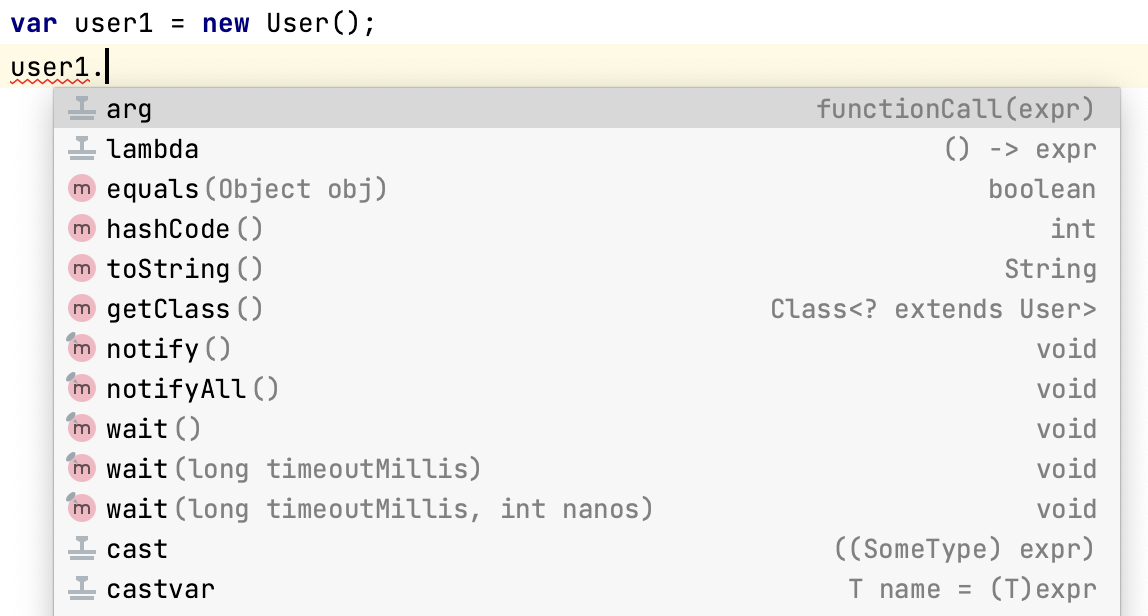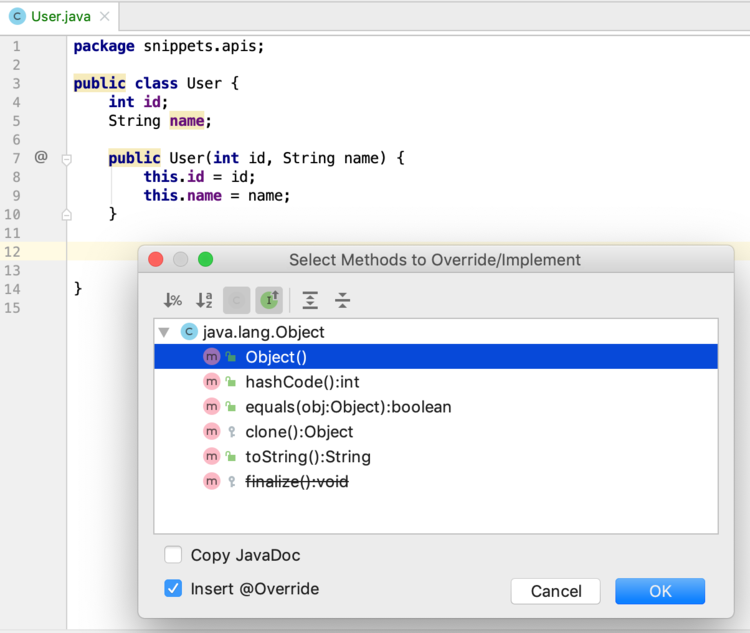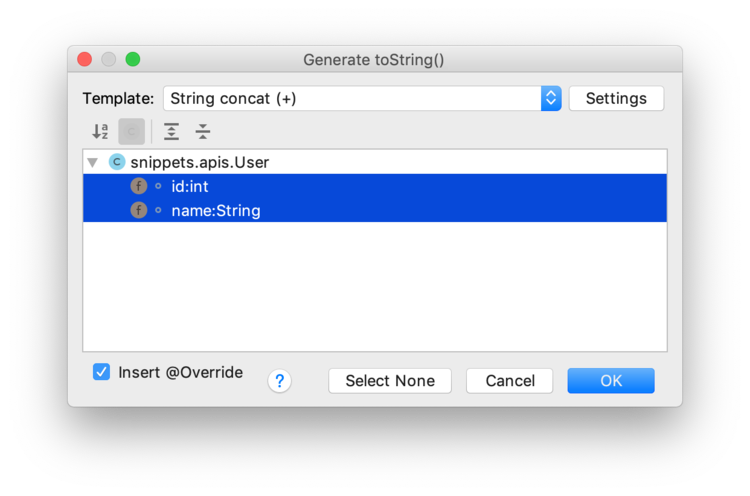14. Methods of class Object#
14.1. Introduction#
Previously you have seen some collection types: List, Map and Set.
One of the methods that is universal to all collection types is contains().
How does the JVM determine that two objects are equal?
This is through the equals() method.
When you use the statement myCollection.contains(myObject), you get true returned if at least one of the elements in myCollection returns true for element.equals(myObject).
The method equals() is there, even though you did not implement it. This is because they are declared and implemented in class Object,
Every class extends from Object
In Java, every class extends from class Object implicitly. Whenever you create a class, such as this:
class User {
//class code
}
you get this implicitly:
class User extends Object {
//class code
}
Since User extends Object, it inherits all Object properties and methods. If you create an object (of any type), type the variable name followed by a dot, and IntelliJ (and most other IDEs) will show you the methods of class Object:

The notify..() and wait..() methods have to do with multithreading and are not dealt with here, and neither are the things in grey (e.g. arg and lambda).
The ones of interest are
The methods below are always inherited and also provide a default implementation that you may or may not wish to keep using.
toString()returns a String representation of the current object. Implemented in class Object as the objects’ memory hash.equals()returns a boolean indicating whether the argument is logically the same as the current object. Implemented in class Object as:trueif both refer to the same object in memory (the object heap).hashCode()returns the hashCode (an int) of the current object. Implemented in class Object to return an integer representing the objects memory address.getClass()returns the class of the current object
14.2. toString(): an object string representation#
If you want to see a nice textual representation of an object during software development, you use toString().
In IntelliJ, type ctrl + O if you want to override a super class method.

If you choose toString(), you will get something like this:
@Override
public String toString() {
return super.toString();
}
Note the @Override annotation.
Annotations are syntactic sugar in Java, and this one communicates to the compiler:
“please check whether this override is correct, else fail compilation”.
Correct with respect to toString() means: take no arguments and return a String.
The statement return super.toString(); simply states: call the super class toString (of Object in this case) and return its result. Which means you get the uninformative default implementation:
snippets.apis.User@78b1cc93
To make toString useful, you’ll need te redefine its logic, for instance:
@Override
public String toString() {
return "A user with name " + name;
}
which outputs A user with name Henk
Although this is logically correct, and will compile just fine, there are some conventions used in Java to be informative. To get a toString() which follows this rule, use another IntelliJ shortcut: ctrl + N (for generate code), and select toString().

Then, select the instance variables you want included in the string representation, click OK and you have something like this
@Override
public String toString() {
return "User{" +
"id=" + id +
", name='" + name + '\'' +
'}';
}
outputting User{id=15, name='Henk'}, which is a good textual representation of the underlying object.
14.3. equals() determining logical similarity between objects#
Consider these three User objects, where the first constructor argument is the user ID and the second the username.
User user1 = new User(15, "Henk");
//same, equal?
User user2 = user1;
User user3 = new User(21, "Dirk");
//same, or equal User as user3?
User user4 = new User(21, "Dirk");
Is user1 equal to user2? Is user1 equal to itself, user1? Is user3 equal to user4?
equality versus sameness
Two references are considered the same if they both point to a single object on the heap. On the other hand, equality is a more fuzzy concept. In general, we consider two references to be equal if they point either to one single object, or to two distinct objects that are logically similar. Thus, same object references are always equal but not all equal objects are same.
So, in the above code snippet, user1 is definitely the same as user2 two since they refer to the same object.
And since they are the same, they are therefore also equal.
On the other hand, user3 and user4 are two distinct objects (not the same - the constructor has run twice), but logically similar because they have exactly the same internal data.
Note
In Java, == tests for sameness and equals() for logical similarity.
Therefore, we would like our User class to behave like this.
System.out.println("user1 == user1 -- " + (user1 == user1)); //should be true
System.out.println("user1.equals(user1) -- " + user1.equals(user1)); //should be true
System.out.println("user1 == user2 -- " + (user1 == user2)); //should be true
System.out.println("user1.equals(user2) -- " + user1.equals(user2)); //should be true
System.out.println("user1.equals(user3) -- " + user1.equals(user3)); //should be false
System.out.println("user3.equals(user4) -- " + user3.equals(user4)); //should be true!
but in actuality this is what we get
user1 == user1 -- true user1.equals(user1) -- true user1 == user2 -- true user1.equals(user2) -- true user1.equals(user3) -- false user3.equals(user4) -- false
Up to the last test, everything works out fine. Why does the last test return false? Because Java doesn’t not know about logical similarity between User objects! We have to tell it. Therefore, by default this is what the Object.equals() default implementation does:
@Override
public boolean equals(Object other) {
return (this == other);
}
Let’s change the equals() method to reflect (my opinion of) similarity:
@Override
public boolean equals(Object other) {
User otherUser = (User) other;
return (this.id == otherUser.id && this.name == otherUser.name);
}
Although this is conceptually a correct implementation, there is a lot to say about it. Can you spot the flaws?
There are several, so maybe it is better to let IntelliJ handle this for us, via ctrl + N (generate) → equals() and hashCode() → choose template (IntelliJ Default), choose name and ID –> next, next next, Create:
@Override
public boolean equals(Object o) {
// shortcut if they are the same!
if (this == o) return true;
// not the same class -- not possibly equal
if (o == null || getClass() != o.getClass()) return false;
//cast to correct class to finally check properties
User user = (User) o;
//short-circuited if statement on id property
if (id != user.id) return false;
// delegate other objects' equality to their respective implementations
return Objects.equals(name, user.name);
}
The equals() method must exhibit the following properties:
Symmetry: For two references, a and b, a.equals(b) if and only if b.equals(a) as well
Reflexivity: For all non-null references, a.equals(a)
Transitivity: If a.equals(b) and b.equals(c), then a.equals(c)
Consistency with hashCode(): Two equal objects must have the same hashCode() value
Warning
When you implement equals(), you should always also implement hashCode().
14.4. hashCode(): required when equals() is implemented#
The hashCode() method is kind of the mysterious sister of equals(). You implement them together, but only equals() is easily understood.
The hashCode() method is used for bucketing in Hash implementations like HashMap, HashTable, HashSet, etc.
The value received from hashCode() is used as the bucket “number” for storing elements of the set/map.
This bucket number is the address of the element inside the set/map.
When you do contains() it will take the hash code of the element, then look for the bucket where hash code points to.
If more than 1 element is found in the same bucket (multiple objects can have the same hash code), then it uses the equals() method to evaluate if the objects are equal, and then decide
if contains() is true or false, or decide if element could be added in the set or not.
(This paragraph is copied from a post on Stackoverflow)
The general contract of hashCode() states:
Whenever it is invoked on the same object more than once,
hashCode()must consistently return the same value, provided no information used in equals comparisons on the object is modified. This value needs not remain consistent from one execution of an application to another execution of the same applicationIf two objects are equal according to the
equals(Object)method, then calling thehashCode()method on each of the two objects must produce the same valueIt is not required that if two objects are unequal according to the
equals(java.lang.Object)method, then calling the hashCode method on each of the two objects must produce distinct integer results. However, developers should be aware that producing distinct integer results for unequal objects improves the performance of hash tables
Of course, we let IntelliJ do the hard work (ctrl + N):
@Override
public int hashCode() {
// delegates to a utility method from class Objects
return Objects.hash(id, name);
}
Note
Class Objects should not be confused with class Object. Class Objects contains a variety of utility methods such as the one above, as well as methods for efficient error checking. Here are a few examples.
requireNonNull()checkIndex()compare()
See Javadoc
14.5. getClass() gives meta-information on the objects’ class#
Example code is best here:
System.out.println("user1.getClass().getSimpleName() = " + user1.getClass().getSimpleName());
System.out.println("user1.getClass().getName() = " + user1.getClass().getName());
System.out.println("user1.getClass().getPackageName() = " + user1.getClass().getPackageName());
outputs
user1.getClass().getSimpleName() = User user1.getClass().getName() = snippets.apis.User user1.getClass().getPackageName() = snippets.apis
There are a lot more methods in class java.lang.Class, but they serve difficult stuff, like introspection.
